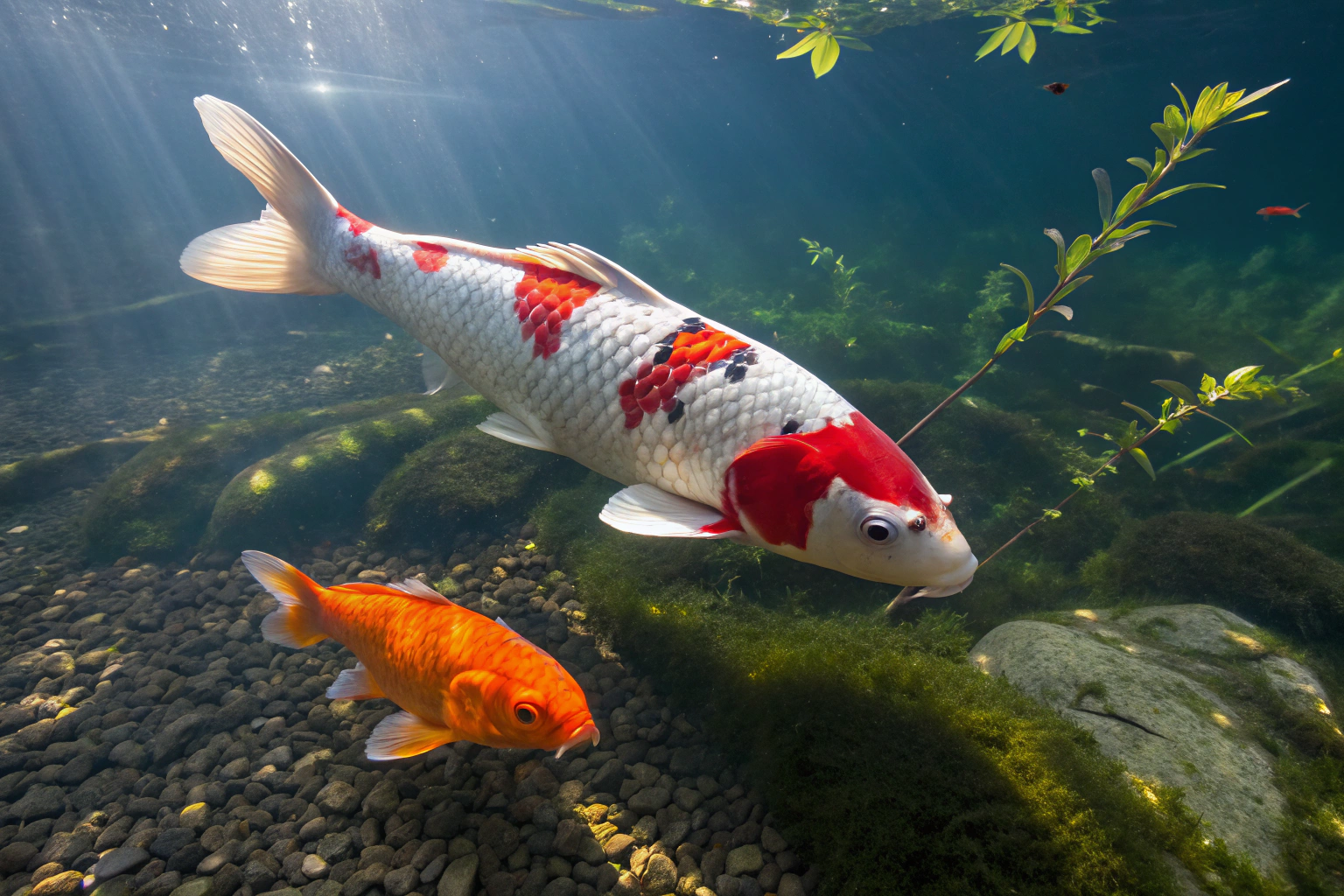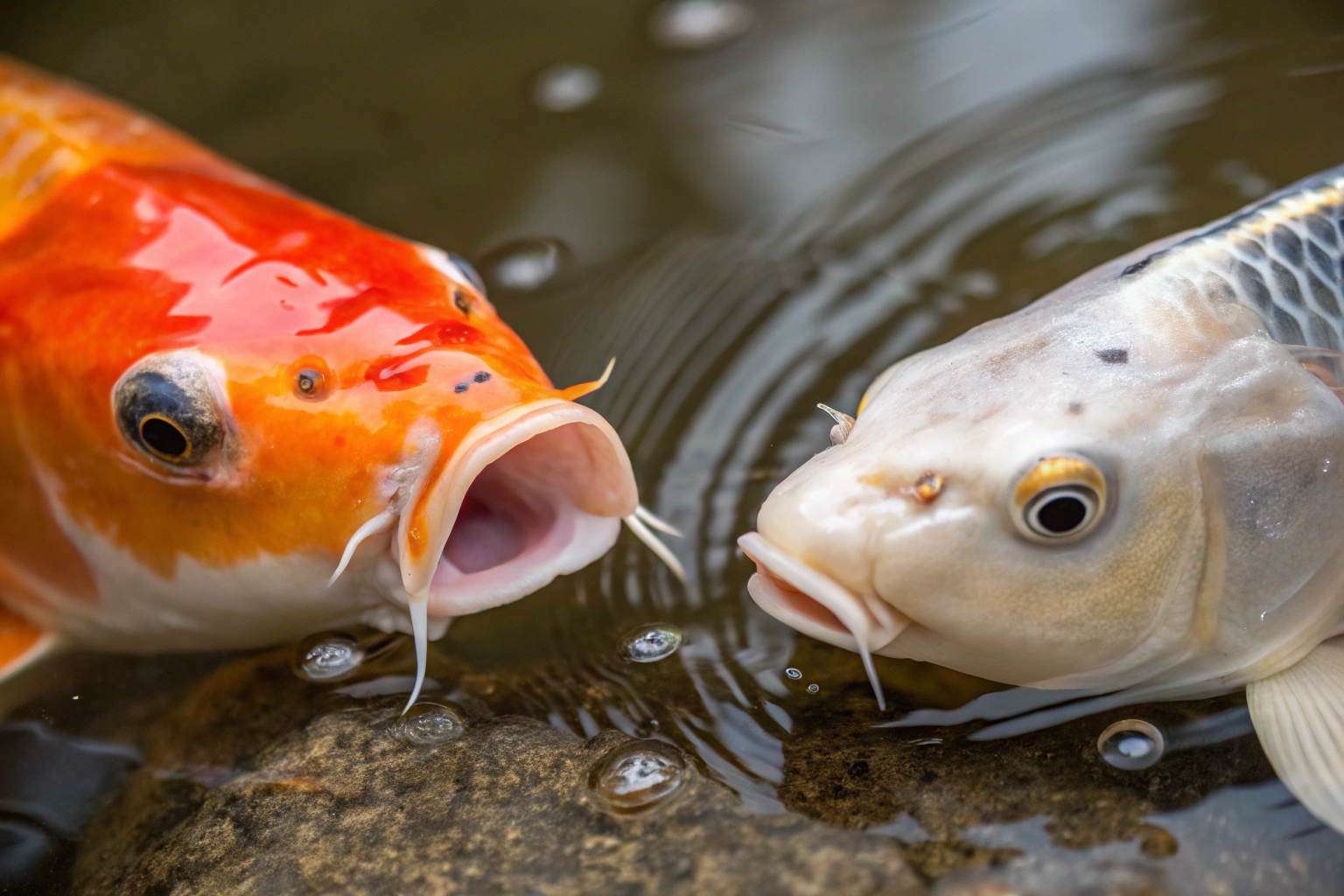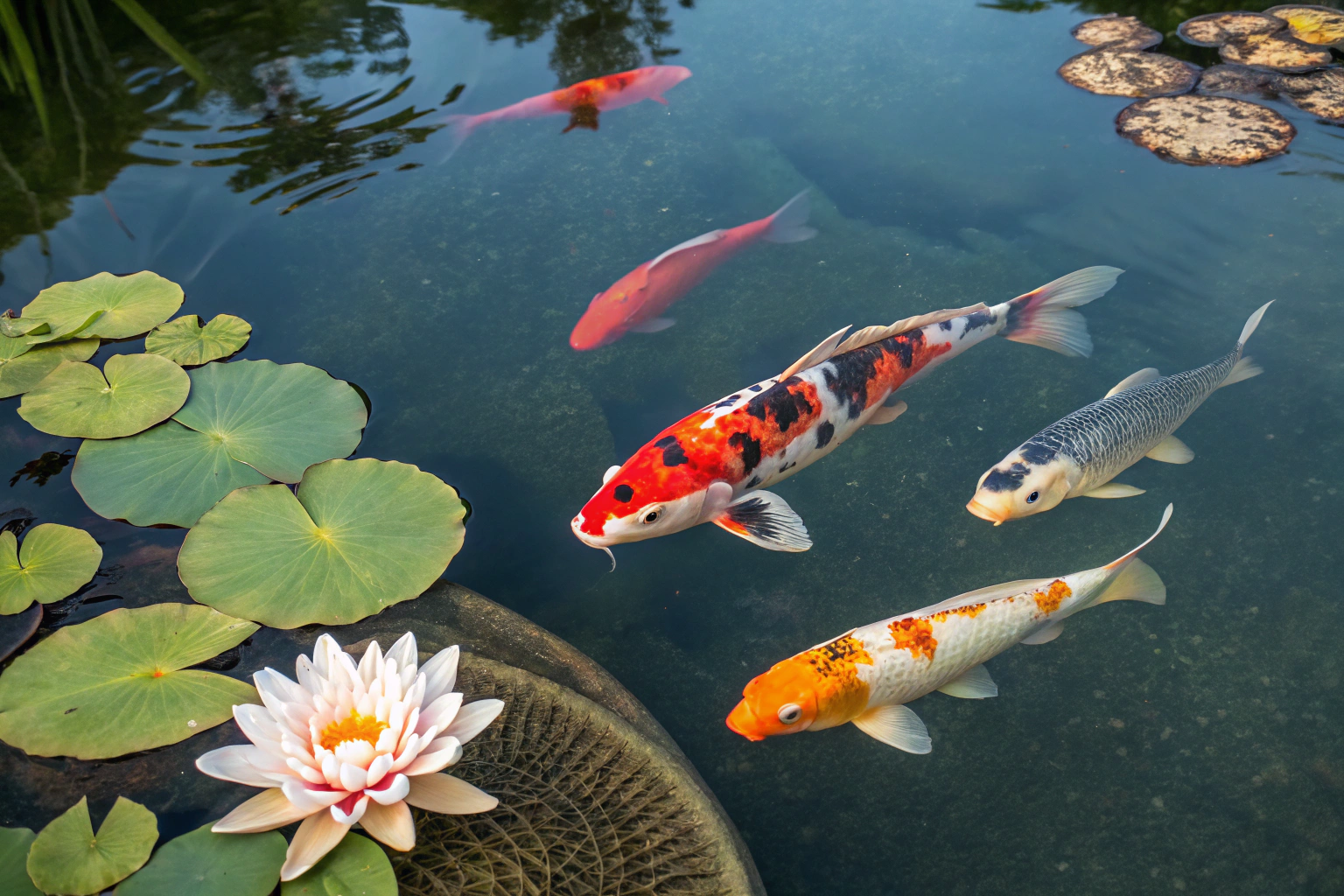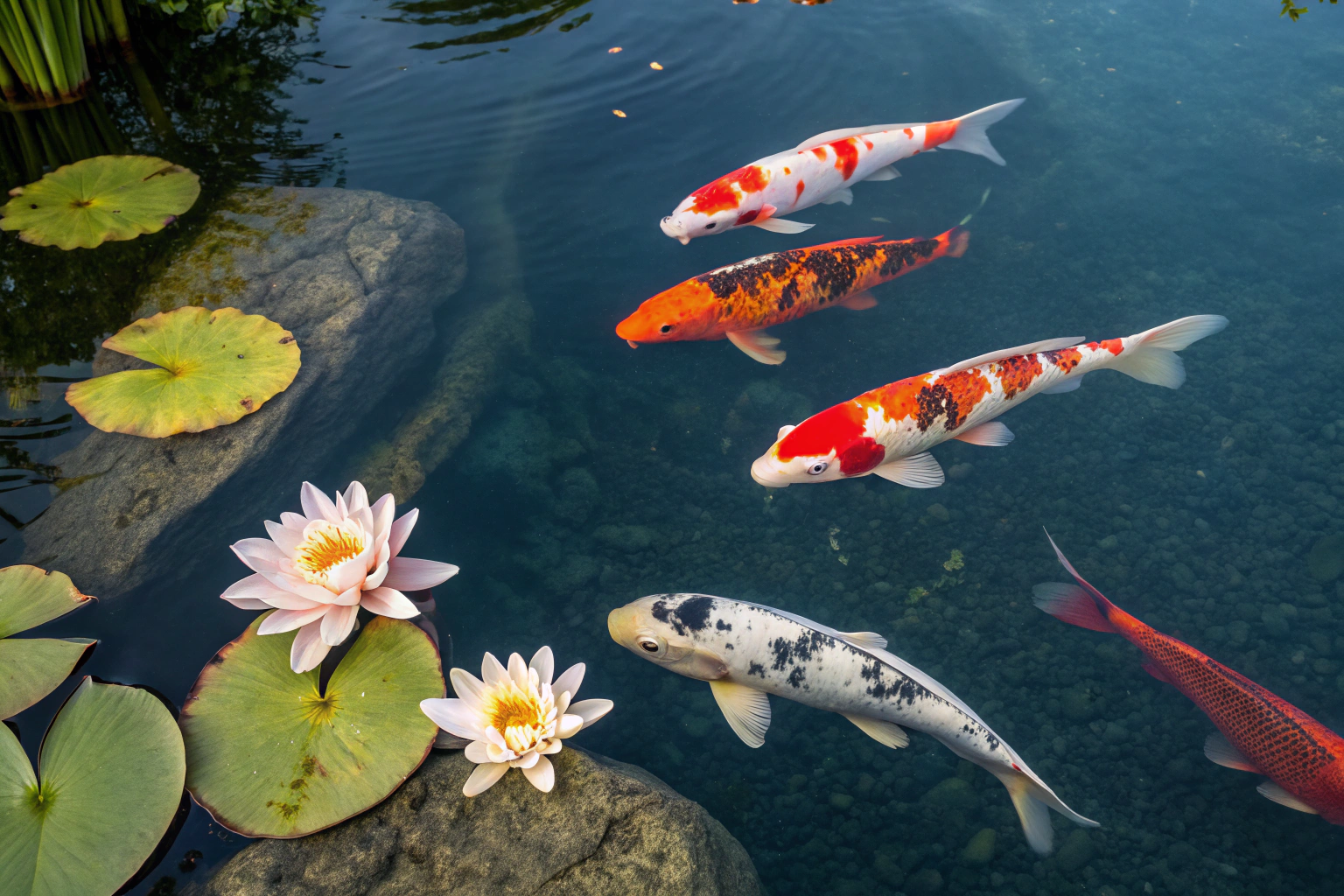What’s the Real Difference Between Koi and Goldfish?
This post may contain affiliate links.
For the casual observer, the vibrant inhabitants of a garden pond might all seem like variations of the same theme – colourful fish gracefully navigating the water. However, among the most popular pond dwellers, Koi (Cyprinus rubrofuscus ‘koi’) and Goldfish (Carassius auratus), lie distinct differences rooted in history, genetics, and physical characteristics. While both belong to the Cyprinidae family, tracing their ancestry back to carp, they represent separate species shaped by centuries of selective breeding for vastly different aesthetic goals. Understanding these distinctions is crucial not only for appreciating their unique beauty but also for providing the appropriate care and environment each species requires. This article delves into the key differences, exploring their origins, size potential, physical forms, colour variations, lifespans, costs, and environmental needs to paint a clear picture of what truly sets Koi and Goldfish apart.

A Tale of Two Carps: Distinct Origins
While often found sharing the same pond, Koi and Goldfish embarked on their evolutionary journeys from different branches of the carp family tree, diverging centuries ago due to distinct breeding programs in East Asia. Goldfish boast the longer history, tracing their lineage back over a thousand years to the Prussian carp (Carassius gibelio) in China. Initially bred for food during the Jin dynasty, mutations leading to vibrant yellow and orange colourations were occasionally observed. These unusually coloured fish were selectively bred, initially in imperial ponds during the Song dynasty and later becoming popular pets across various social strata. This selective breeding focused primarily on colour and later, on diverse body shapes and finnage, leading to the wide array of fancy goldfish known today. As noted by experts at Next Day Koi, roughly 200 recognized goldfish breeds exist, showcasing a millennium of dedicated cultivation.
Koi, in contrast, have a more recent, though equally fascinating, origin story. They are descendants of the Amur carp (Cyprinus rubrofuscus), a species native to East Asia. While coloured carp mutations likely occurred earlier, the focused breeding of Nishikigoi (brocaded carp), as Koi are known in Japan, began in the Niigata prefecture during the 1820s. Japanese rice farmers started selectively breeding Amur carp that displayed interesting colour patches, initially red, white, and yellow. Unlike goldfish breeding, which diversified body forms early on, Japanese breeders concentrated intensely on refining colour purity, patterns, and scale quality, while largely maintaining the carp’s original torpedo-like body shape. This dedication resulted in the stunning, classified varieties we see today, grouped into distinct classes based on intricate colour patterns and scalation.

Size Matters: Growth Potential
One of the most striking and practical differences between Koi and Goldfish lies in their potential size. Koi are significantly larger fish, capable of reaching impressive lengths that demand spacious accommodations. On average, a well-cared-for Koi will grow to between 20 and 25 inches (50-64 cm), but champion specimens in optimal pond environments can exceed three feet (nearly 1 meter) in length. This substantial size is a direct inheritance from their Amur carp ancestors.
Goldfish, conversely, remain considerably smaller. Common varieties typically reach lengths of 6 to 8 inches (15-20 cm). While some varieties, particularly single-tailed pond types like Comets or Shubunkins, can grow larger, potentially reaching 10 to 12 inches (25-30 cm) or slightly more under ideal conditions with ample space, they rarely approach the dimensions of even average-sized Koi. As highlighted by pond specialists at Blue Ridge Koi, this size difference is a primary consideration when planning a pond, as Koi require significantly more water volume per fish to thrive.
Form Follows Function: Body Shape and Features
Beyond sheer size, Koi and Goldfish exhibit distinct body shapes and anatomical features that reflect their breeding history and, to some extent, their ancestral adaptations. Koi generally retain the streamlined, torpedo-like shape of their carp progenitors. Their bodies are elongated and relatively lean, built for efficient movement through water. A key identifier, absent in goldfish, is the presence of barbels – whisker-like appendages near the mouth, used for locating food in substrate. Koi mouths are typically downward-facing (subterminal), suited for bottom-feeding. Their eyes are generally flush with the head, and their dorsal (top) fin runs smoothly along the back, often appearing visually connected to the tail fin.
Goldfish, particularly the numerous ‘fancy’ varieties, display a much wider range of body shapes, often deviating significantly from the ancestral carp form. While common pond goldfish might be somewhat elongated, many breeds are characterized by shorter, rounder, and deeper bodies – think of the egg-like shape of Orandas or Ranchus. Their mouths are typically forward-facing (terminal) with rounded jaws. Crucially, goldfish lack barbels entirely. Eye shape can also vary dramatically in goldfish, from the normal eyes of Comets to the protruding telescopic eyes of Moors or the celestial upward-gazing eyes of some breeds. Furthermore, as detailed by suppliers like Blue Ridge Koi, goldfish finnage is incredibly diverse, featuring single or double tails (caudal fins) and variations in the length and shape of dorsal, pectoral, pelvic, and anal fins. While most Koi have relatively standard fin shapes, the exception is the Butterfly Koi (or Hirenaga), specifically bred for long, flowing fins, though their underlying body shape remains distinctly Koi.

A Spectrum of Hues: Coloring and Patterns
The visual appeal of both Koi and Goldfish is largely defined by their colouration, yet the diversity and focus differ significantly between the species. Goldfish primarily exhibit shades of orange, red, yellow, white, black, and calico combinations. While beautiful, their colour palette is generally less extensive than that of Koi. Historically, goldfish breeding emphasized variations in body shape, finnage, and eye configuration over the intricate development of colour patterns seen in Koi. However, goldfish do present different scale types that affect their appearance: metallic (shiny), nacreous (pearly, often seen in Shubunkins), and matte (non-reflective).
Koi, on the other hand, are renowned for their breathtaking array of colours and complex patterns, which form the basis of their classification and value. While they share the basic colours found in goldfish, Koi varieties extend into stunning blues, greens, greys, silvers, golds, and deep blacks (sumi). Japanese breeders have meticulously cultivated specific patterns (like Kohaku – red on white, Sanke – red and black on white, Showa – black with red and white) and scale types (like Gin Rin – sparkling scales, or Doitsu – scaleless or partially scaled). This intense focus on colour and pattern development, as opposed to body shape, means Koi offer an almost endless \’artistic palette\’ for pond enthusiasts, a point often emphasized by retailers like Next Day Koi. The precision of patterns, clarity of colour edges (kiwa), and overall balance are critical factors in judging Koi quality.
Living Longer: Lifespan Expectations
A significant divergence between Koi and Goldfish lies in their potential lifespans. Koi are remarkably long-lived fish, often outliving many other common pets. With proper care, good water quality, and a suitable environment, the average lifespan for a Koi ranges from 25 to 35 years. However, many Koi live much longer, with individuals documented to have reached 50, 70, or even more years. The most famous example, albeit debated, is “Hanako,” a scarlet Koi reported to have lived for 226 years in Japan.
Goldfish, while still capable of living for a respectable duration compared to many aquarium fish, have considerably shorter lifespans than Koi. The average lifespan for a common or pond goldfish is typically around 10 to 15 years. Fancy goldfish varieties often have shorter lifespans, sometimes only 5 to 10 years, due to health issues associated with their specialized body shapes. While exceptional goldfish have been recorded living past 40 years, this is rare. This difference in longevity, as noted by resources like Blue Ridge Koi, is a major commitment factor, especially when choosing Koi.

Investment and Value: The Cost Factor
The initial and ongoing cost associated with keeping Koi versus Goldfish can also differ substantially. Generally, Goldfish are much more affordable to acquire. Common varieties can often be purchased for very low prices, sometimes less than a dollar or a few dollars each, especially when young. Even high-quality fancy goldfish or larger pond-suitable specimens typically range from modest prices up to several hundred dollars for exceptional individuals.
Koi, conversely, represent a potentially much larger financial investment. While young, standard-grade Koi might be available for prices comparable to higher-end goldfish (starting from $10-$20), the cost escalates rapidly based on size, age, variety, colour quality, pattern precision, and lineage. Show-quality Koi from prized bloodlines can command prices ranging from hundreds to thousands, and even tens of thousands of dollars. Grand champion Koi at major shows have famously sold for hundreds of thousands, or even millions, of dollars. This vast price difference, highlighted by suppliers like Next Day Koi, reflects the specialized breeding, rarity, and cultural value attached to high-grade Nishikigoi. Beyond the purchase price, the larger size and specific needs of Koi often translate to higher costs for pond construction, filtration systems, and food compared to a typical goldfish setup.
Habitat Requirements: Pond Environment
Both Koi and Goldfish are relatively hardy and adaptable fish, capable of thriving in outdoor ponds across a range of temperatures, provided the water quality is maintained. However, their differing sizes dictate significantly different spatial requirements. Due to their large potential size and active nature, Koi require substantial ponds. A common recommendation is a minimum of 1,000 gallons (approx. 3,800 liters) for the first few Koi, with an additional 100-200 gallons (380-760 liters) per additional fish, although more volume is always better. Pond depth is also critical, especially in climates with freezing winters or hot summers; a minimum depth of 3 feet (approx. 1 meter) is advised, with depths of 4-6 feet (1.2-1.8 meters) or more being preferable in colder regions to allow fish to safely overwinter below the ice layer. Robust filtration is essential for Koi ponds due to the significant waste they produce.
Goldfish, being smaller, can be comfortably housed in smaller ponds or even large water features. While specific volume requirements vary by breed and number of fish, a pond of several hundred gallons can often suffice for a small group. A minimum depth of 2 feet (60 cm) is generally recommended for pond goldfish to provide protection from predators and temperature extremes. While filtration is still crucial for maintaining water quality, the demands on the system are typically less intensive than for a similarly stocked Koi pond. Resources like Splash Supply Co. often provide guidance on appropriate pond sizing for both species.

Peaceful Coexistence? Compatibility in the Pond
Given their shared ancestry and relatively peaceful temperaments, Koi and Goldfish are often kept together successfully in the same pond. Both species are generally non-aggressive towards each other and share similar dietary and water quality requirements, making mixed ponds feasible and popular. They are both omnivores with similar feeding habits, although specific food pellet sizes might need consideration depending on the size difference between the fish.
However, potential compatibility issues can arise, primarily related to size disparity and breeding. Large Koi may inadvertently injure very small goldfish, or potentially even consume goldfish fry or extremely small individuals, mistaking them for food. Therefore, it\’s generally advised to introduce goldfish that are already of a reasonable size when housing them with adult Koi. Conversely, during spawning season, the vigorous chasing behaviour of breeding males (both Koi and Goldfish) can sometimes stress or injure smaller or slower-moving fish, particularly fancy goldfish varieties with elaborate finnage or compromised swimming ability. While Koi and Goldfish belong to different species (Cyprinus vs. Carassius), hybridization, though rare, is technically possible but typically results in sterile offspring that lack the desirable characteristics of either parent species. Careful consideration of stocking levels, size matching, and providing ample space and hiding places can help ensure harmonious coexistence, a topic often discussed in pond care guides like those found at Tampa Bay Pond & Rocks.
